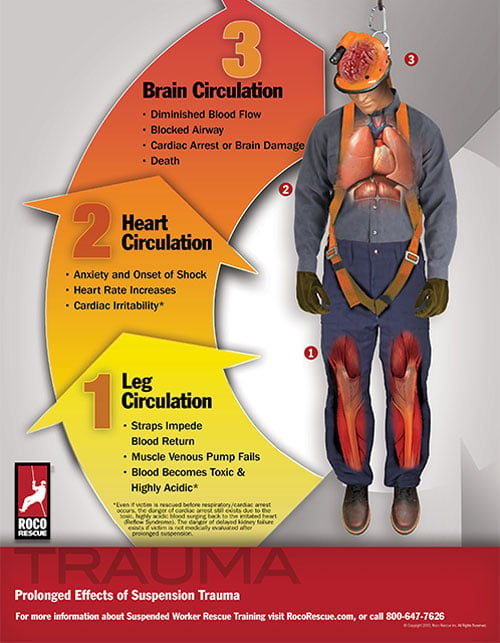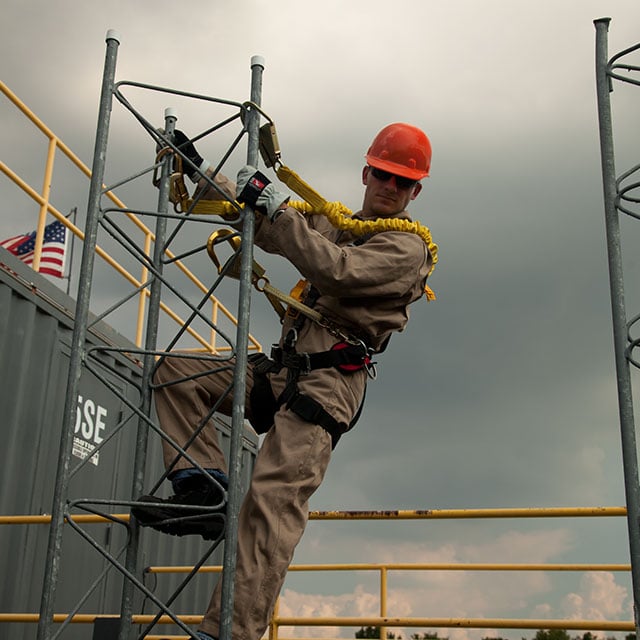 What exactly is suspension trauma? How does it occur? And what can be done to prevent it?
What exactly is suspension trauma? How does it occur? And what can be done to prevent it?
Suspension Trauma - otherwise known as harness pathology, distributive shock, or orthostatic intolerance - has recently been identified by OSHA as a workplace hazard particular to Authorized Workers using personal fall arrest systems (PFAS). More and more employers are becoming aware of this workplace hazard and are taking appropriate steps to protect their employees. The range of understanding on the cause of the hazard, as well as how to protect against it, is pretty vast.
Our new Suspension Trauma Safety Poster is a tool to raise awareness of this hazard. It illustrates the pathological path that a fallen suspended worker may experience. Please share with colleagues, fellow safety professionals and especially workers that use PFAS. It could save a life.
The rate at which suspension trauma develops varies from individual to individual and is not reliably predictable. However, there are factors that influence the potential for suspension trauma as well as the speed of onset. Here are a few examples:
- Underlying physical condition of worker including any pre-existing respiratory or cardiac conditions;
- Worker’s ability to handle stress and anxiety;
- Harness selection, fit, and adjustment;
- Traumatic injuries that may have occurred during or before the fall; and,
- Knowledge and the use of equipment or techniques to delay the onset of suspension trauma such as temporary leg stirrups or simply “bicycling the legs.”
Roco also offers a course called Rescue From Fall Protection to educate rescuers who respond to suspended workers.

Pathological Effects of a Fallen Worker in Danger of Suspension Trauma
For those of you who prefer a more detailed explanation, here's the narrative from Roco Chief Pat Furr.
1. Leg Circulation: A fall arrest harness does a great job of dissipating the energies generated during a fall arrest through the long axis of the human body. After all motion has stopped, that same harness – particularly the dorsal attachment configuration – will most likely impose pressure to the femoral vein, which is the primary blood vessel that returns blood from the legs towards the heart. In fact, in order to pass certification testing, these harnesses must not allow the test mannequin to assume greater than a 30 degree forward lean upon suspension. Any degree of forward lean will exert leg strap pressure on the femoral vein which impedes blood return. To compound this, the human body relies on what is known as the muscle/venous pump to assist the blood return from the legs to the heart. In suspension, the worker often forgets to bicycle their legs to create this muscle/venous pump. The trapped blood in the legs creates what is known as distributive shock as more and more blood is trapped in the legs; there is less to circulate for the rest of the body (brain, heart, lungs, and kidneys). Additionally, this blood becomes highly acidic and toxic with metabolic wastes.
 2. Heart Circulation: As the body goes into distributive shock, the heart must increase the rate and strength of its contractions to compensate. To compound this, the suspended worker may be experiencing a high degree of fear and anxiety, which releases adrenalin into the bloodstream which also causes the heart to work harder and faster. This places increased demands on the heart, which is receiving less blood flow and thus less oxygen. The heart becomes irritable and is prone to localized tissue damage, dysrhythmias or both. This is especially a concern once the worker is rescued and the toxic blood is allowed to surge from the legs to the irritable heart. This is known as reflow syndrome and has caused several victims to go into sudden cardiac arrest upon rescue.
2. Heart Circulation: As the body goes into distributive shock, the heart must increase the rate and strength of its contractions to compensate. To compound this, the suspended worker may be experiencing a high degree of fear and anxiety, which releases adrenalin into the bloodstream which also causes the heart to work harder and faster. This places increased demands on the heart, which is receiving less blood flow and thus less oxygen. The heart becomes irritable and is prone to localized tissue damage, dysrhythmias or both. This is especially a concern once the worker is rescued and the toxic blood is allowed to surge from the legs to the irritable heart. This is known as reflow syndrome and has caused several victims to go into sudden cardiac arrest upon rescue.3. Brain Circulation: As the victim goes into distributive shock, or worst case, suffers cardiac arrest, the brain is deprived of adequate blood supply and this can lead to unconsciousness. If the victim faints the airway can be blocked by the head position or even by a poorly adjusted harness that allows the chest strap to block the airway. That is a difficult statement to write into a fatality report “Cause of Death: Strangulation by Victim’s Own PPE.” If the victim’s heart stops, we can expect permanent brain damage or death in as little as four minutes.
So it should be obvious that a prompt rescue capability must be ensured by any employer that has Authorized Persons using PFAS. This can be accomplished in many ways. Roco has a variety of training courses that are specifically designed to provide that prompt rescue capability for fallen/suspended workers.
We also worked with CMC to design a new harness to protect suspended workers from suspension trauma.
For more information please contact Roco Rescue at 800-647-7626 or submit a question to our Tech Panel.





 Span of control is “the number of people one can effectively manage.” The more technical or hands on a training course is, the smaller the number of people a single instructor can safely control.
Span of control is “the number of people one can effectively manage.” The more technical or hands on a training course is, the smaller the number of people a single instructor can safely control. To maintain their service life and high performance, all belts and harnesses should be inspected frequently. Visual inspection before each use should become routine, and also a routine inspection by a competent person. If any of the conditions listed below are found, the equipment should be replaced before being used.
To maintain their service life and high performance, all belts and harnesses should be inspected frequently. Visual inspection before each use should become routine, and also a routine inspection by a competent person. If any of the conditions listed below are found, the equipment should be replaced before being used. So, what is the design load? Typically, it is the amount of weight/force a device or a system can handle; or the load that it is designed to handle. Once it has met the design load requirement for NFPA, it is placed in an equipment category and tested accordingly. In the case of the ID, it is tested as a descent control device. According to NFPA, General Use descent control devices shall withstand a minimum test load of at least 22 k/N (4946 lbf) without failure. I know what you’re thinking, “Hey, that’s not anywhere near the 9000 lbf we’re used to hearing for General Use?” NFPA requires that rope and carabiners be rated at 8992 lbf with pulleys and some other auxiliary items at 8093 lbf. Rope grab device shall withstand a minimum test load of at least 11 k/N (2473 lbf) without sustaining permanent damage to the device or rope to meet General Use. So, there is a wide range of strength requirements in NFPA 1983 depending on what category an item is tested in.
So, what is the design load? Typically, it is the amount of weight/force a device or a system can handle; or the load that it is designed to handle. Once it has met the design load requirement for NFPA, it is placed in an equipment category and tested accordingly. In the case of the ID, it is tested as a descent control device. According to NFPA, General Use descent control devices shall withstand a minimum test load of at least 22 k/N (4946 lbf) without failure. I know what you’re thinking, “Hey, that’s not anywhere near the 9000 lbf we’re used to hearing for General Use?” NFPA requires that rope and carabiners be rated at 8992 lbf with pulleys and some other auxiliary items at 8093 lbf. Rope grab device shall withstand a minimum test load of at least 11 k/N (2473 lbf) without sustaining permanent damage to the device or rope to meet General Use. So, there is a wide range of strength requirements in NFPA 1983 depending on what category an item is tested in.


